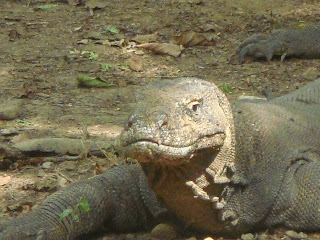 So we spent several hours there in the morning and it was well worth it. It is a very large zoo and
So we spent several hours there in the morning and it was well worth it. It is a very large zoo and was designed largely with the help of the adventurous Australian Steve Irwin (the TV personality that died from the stingray barb), so it is primarily an “open-zoo” concept…rather than cages, natural barriers like streams, rock walls and vegetation separate animals from visitors. It was exceptionally well done but we won’t bore you with dozens of photos of animals. You have to be there to experience it.
was designed largely with the help of the adventurous Australian Steve Irwin (the TV personality that died from the stingray barb), so it is primarily an “open-zoo” concept…rather than cages, natural barriers like streams, rock walls and vegetation separate animals from visitors. It was exceptionally well done but we won’t bore you with dozens of photos of animals. You have to be there to experience it. Next, we took the cable cars from where our ship was docked on two scenic rides, on one side to Mount Faber, a scenic overlook with a great restaurant, and on the other side to Sentosa Island, a resort destination. Sentosa Island currently has several beach resorts and other attractions, and is undergoing huge development in the building of Universal Studios (photo below), several more hotels, and a casino. It will be an amazing place to visit once completed.
Next, we took the cable cars from where our ship was docked on two scenic rides, on one side to Mount Faber, a scenic overlook with a great restaurant, and on the other side to Sentosa Island, a resort destination. Sentosa Island currently has several beach resorts and other attractions, and is undergoing huge development in the building of Universal Studios (photo below), several more hotels, and a casino. It will be an amazing place to visit once completed.
A visit to Singapore would not be complete without some shopping, as Singapore is known as a shopper’s paradise. The most famous shopping area is along Orchard Road, but the more colorful ethnic shops are found in the sectors of Little India, Arab Street and Chinatown. The latter we took in yesterday, and with limited time, we did some damage in the 1 million square foot HarbourFront complex before returning to the ship.
Another day now at sea en route to Vietnam.
Another day now at sea en route to Vietnam.

















 Heading back to the port, we took a different route and stopped at a local wood carving shop and one of the many temples on the island.
Heading back to the port, we took a different route and stopped at a local wood carving shop and one of the many temples on the island. 



 We knew in advance that the creatures were not caged in or penned in by any means.
We knew in advance that the creatures were not caged in or penned in by any means.

 The voyage leaving Komodo Island past the many islands of Indonesia was quite picturesque, (as the following pictures show) and a relaxing end to a very odd day
The voyage leaving Komodo Island past the many islands of Indonesia was quite picturesque, (as the following pictures show) and a relaxing end to a very odd day




 Our excursion was a catamaran trip 70 miles offshore to the Great Barrier Reef, where we docked at a floating outpost in the middle of the Coral Sea to explore the territory. We first took a glass bottom boat to see the reef from above, and then a semi-submarine vehicle to see the view below through the glass.
Our excursion was a catamaran trip 70 miles offshore to the Great Barrier Reef, where we docked at a floating outpost in the middle of the Coral Sea to explore the territory. We first took a glass bottom boat to see the reef from above, and then a semi-submarine vehicle to see the view below through the glass.








 On Monday morning, we arrived in Brisbane, Australia. Brisbane is Australia’s third largest city and the capital of Queensland. The center of Brisbane occupies a peninsula bounded on the sea on one side and the Brisbane River on the other. The river meanders through the city, and gardens, parklands and flowering trees border its avenues.
On Monday morning, we arrived in Brisbane, Australia. Brisbane is Australia’s third largest city and the capital of Queensland. The center of Brisbane occupies a peninsula bounded on the sea on one side and the Brisbane River on the other. The river meanders through the city, and gardens, parklands and flowering trees border its avenues.




 We also stopped by Michael and Cleo’s house, and spent the afternoon having lunch and walking around the harbour and The Rocks, Sydney’s oldest section which is now a beautiful marketplace.
We also stopped by Michael and Cleo’s house, and spent the afternoon having lunch and walking around the harbour and The Rocks, Sydney’s oldest section which is now a beautiful marketplace.  Our stay in Sydney was capped with an extraordinary evening at the Sydney Opera House to see the the Australian Ballet’s performance of “Firebird and Other Legends.” The Captain hosted this black-tie evening for those thirty of us who are taking the full 92-day Grand Pacific Voyage. We witnessed an exquisite performance and it was a magical evening under the roof of an iconic structure.
Our stay in Sydney was capped with an extraordinary evening at the Sydney Opera House to see the the Australian Ballet’s performance of “Firebird and Other Legends.” The Captain hosted this black-tie evening for those thirty of us who are taking the full 92-day Grand Pacific Voyage. We witnessed an exquisite performance and it was a magical evening under the roof of an iconic structure. 